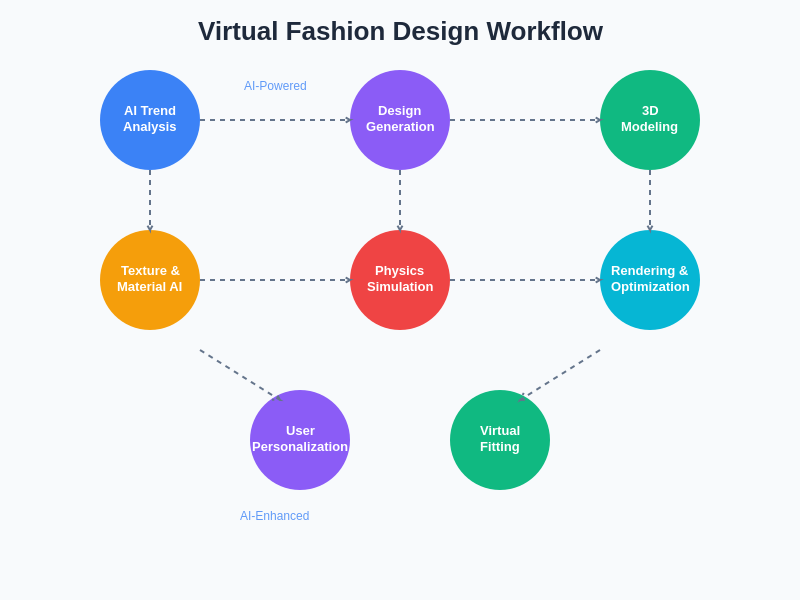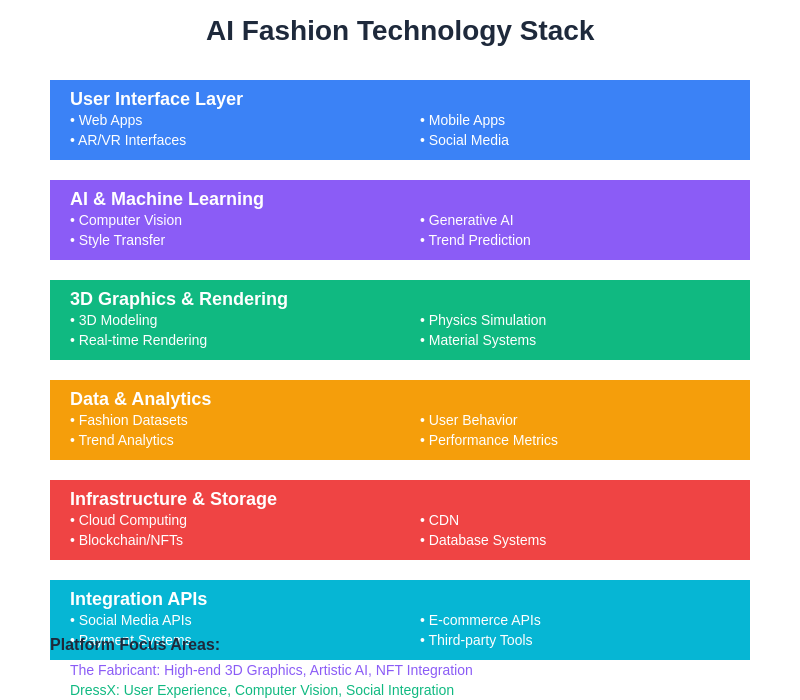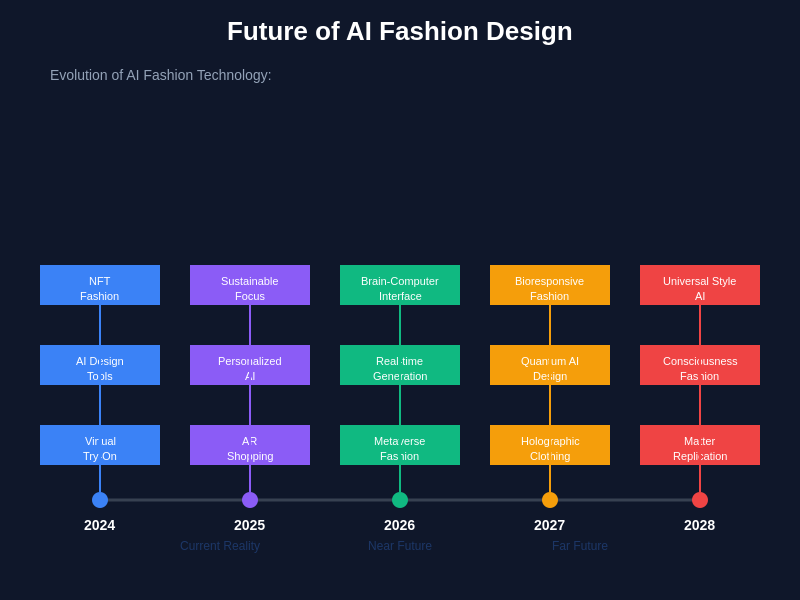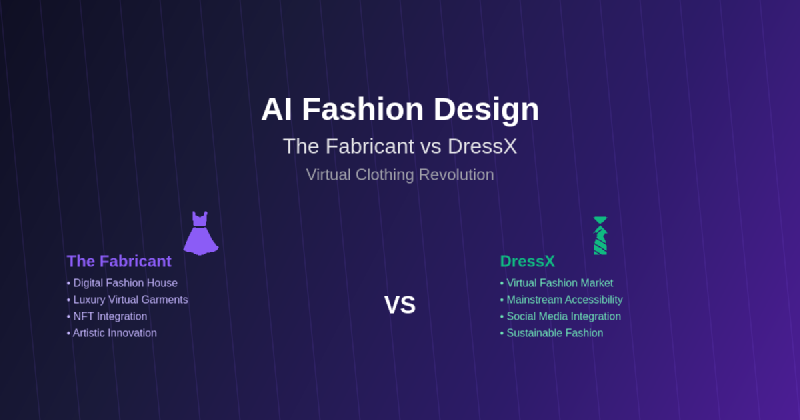The intersection of artificial intelligence and fashion design has emerged as one of the most revolutionary developments in the creative industry, fundamentally transforming how we conceptualize, create, and consume clothing. At the forefront of this digital fashion revolution stand two pioneering platforms that have redefined the boundaries between physical and virtual fashion experiences: The Fabricant and DressX. These innovative companies represent the vanguard of AI-powered fashion design, offering unprecedented opportunities for creative expression, sustainable fashion practices, and immersive digital experiences that challenge traditional notions of clothing ownership and fashion consumption.
Explore the latest AI fashion trends to discover how artificial intelligence is reshaping the fashion industry through virtual clothing design, automated pattern generation, and personalized style recommendations. The convergence of AI technology with fashion creativity has opened new frontiers for designers, consumers, and technology enthusiasts alike, creating a dynamic ecosystem where digital craftsmanship meets cutting-edge innovation.
The Revolutionary Landscape of AI Fashion Design
The emergence of AI-powered fashion design represents a fundamental shift from traditional garment creation methodologies toward algorithmically-driven creative processes that can generate infinite variations of clothing designs, textures, and silhouettes. This transformation has been accelerated by advances in machine learning, computer graphics, and digital fabrication technologies that enable designers to explore creative possibilities previously constrained by physical limitations and manufacturing costs.
AI fashion design platforms leverage sophisticated algorithms to analyze fashion trends, consumer preferences, historical design patterns, and cultural influences to generate novel clothing concepts that resonate with contemporary aesthetic sensibilities while pushing the boundaries of creative expression. These systems can process vast datasets of fashion imagery, runway shows, street style photography, and consumer behavior data to identify emerging trends and predict future fashion directions with remarkable accuracy.
The democratization of fashion design through AI tools has empowered independent creators, emerging designers, and fashion enthusiasts to participate in the creative process without requiring extensive technical skills or substantial financial investment. This accessibility has fostered a diverse ecosystem of digital fashion creators who contribute to an ever-expanding universe of virtual clothing options that cater to increasingly sophisticated consumer demands for personalization and uniqueness.
The Fabricant: Pioneering Digital Fashion House
The Fabricant has established itself as the world’s first digital fashion house, operating exclusively in virtual environments to create stunning garments that exist purely in digital form. Founded with the vision of creating fashion without physical constraints, The Fabricant has developed a sophisticated ecosystem that combines high-end fashion design principles with cutting-edge 3D modeling, artificial intelligence, and blockchain technology to produce virtual clothing that rivals physical garments in visual impact and creative sophistication.
The platform’s approach to AI fashion design centers on collaborative creation between human designers and artificial intelligence systems that can generate, modify, and optimize virtual garments based on specific aesthetic criteria, functional requirements, and consumer preferences. This symbiotic relationship between human creativity and machine intelligence has resulted in groundbreaking fashion collections that push the boundaries of what is possible in traditional fashion design while maintaining the artistic integrity and cultural relevance that define high-quality fashion.

The Fabricant’s proprietary AI systems can analyze fashion trends, consumer behavior patterns, and aesthetic preferences to generate personalized fashion recommendations and create custom virtual garments that reflect individual style preferences while incorporating emerging design trends. This personalization capability has made The Fabricant particularly appealing to consumers seeking unique digital fashion experiences that reflect their personal identity and aesthetic values.
Experience advanced AI capabilities with Claude for fashion design applications that require sophisticated pattern recognition, trend analysis, and creative generation capabilities. The integration of advanced AI systems in fashion design workflows has enabled unprecedented levels of customization and creative exploration that traditional fashion design processes cannot match.
DressX: Democratizing Virtual Fashion
DressX has positioned itself as the leading marketplace for digital fashion, creating an accessible platform where consumers can purchase, own, and wear virtual clothing across various digital environments including social media, virtual reality spaces, and augmented reality applications. The platform’s approach to AI fashion design focuses on making virtual clothing accessible to mainstream consumers while maintaining high standards of design quality and visual realism.
The DressX platform utilizes advanced AI algorithms to facilitate seamless integration of virtual garments with user photographs, creating photorealistic images that showcase how digital clothing appears when worn by real people. This technology has revolutionized the concept of fashion consumption by enabling users to experience wearing high-fashion designs without the environmental impact, storage requirements, or financial investment associated with physical clothing purchases.
DressX’s AI-powered fitting technology represents a significant advancement in virtual fashion accessibility, utilizing computer vision and machine learning algorithms to automatically adjust virtual garments to match individual body types, poses, and lighting conditions. This sophisticated fitting process ensures that virtual clothing appears natural and well-fitted regardless of the user’s physical characteristics or the photographic conditions under which the virtual garment is applied.
Comparative Analysis of Design Philosophies
The fundamental design philosophies of The Fabricant and DressX reflect different approaches to AI fashion design that cater to distinct market segments and use cases. The Fabricant emphasizes high-concept, artistic fashion creation that pushes creative boundaries and explores the intersection of technology and haute couture, while DressX focuses on practical virtual fashion solutions that integrate seamlessly into consumers’ daily digital lives.
The Fabricant’s collections often feature avant-garde designs that would be impossible or impractical to produce in physical form, leveraging the limitless possibilities of digital creation to explore new aesthetic territories and challenge conventional fashion norms. These designs frequently incorporate dynamic elements, impossible physics, and surreal visual effects that create immersive fashion experiences designed to captivate and inspire rather than simply clothe.
DressX, in contrast, maintains a focus on wearable virtual fashion that closely mimics the appearance and behavior of physical clothing while offering the convenience and sustainability benefits of digital consumption. The platform’s catalog includes everything from casual streetwear to formal evening wear, ensuring that consumers can find virtual clothing options for any occasion or style preference.
Technological Infrastructure and AI Capabilities
Both platforms have invested heavily in developing sophisticated technological infrastructure that supports AI-powered fashion design workflows, though their specific implementations and focus areas differ significantly. The Fabricant has developed proprietary tools for 3D garment modeling, texture generation, and physics simulation that enable designers to create highly realistic virtual clothing with complex material properties and dynamic behaviors.
The platform’s AI systems excel at generating novel fabric textures, predicting how virtual materials will behave under different lighting conditions, and optimizing garment geometry for maximum visual impact. These capabilities have enabled The Fabricant to create virtual clothing collections that achieve unprecedented levels of realism and artistic sophistication while maintaining the flexibility and creative freedom that define digital fashion.
DressX has focused its technological development on user experience optimization, creating AI systems that can automatically adjust virtual garments to match user photographs, predict optimal sizing and fit parameters, and recommend complementary fashion items based on individual style preferences. The platform’s computer vision algorithms can analyze user photographs to determine body measurements, pose characteristics, and lighting conditions, ensuring that virtual clothing appears natural and well-integrated.

The technical sophistication of both platforms extends to their integration capabilities, with robust APIs and development tools that enable third-party applications, social media platforms, and virtual reality environments to incorporate virtual fashion functionality. This extensibility has been crucial for building the ecosystem partnerships that drive adoption and usage of virtual fashion solutions.
Enhance your research capabilities with Perplexity to stay informed about the latest developments in AI fashion technology, virtual clothing platforms, and digital fashion trends. The rapid evolution of this industry requires continuous learning and adaptation to emerging technologies and consumer preferences.
Market Positioning and Target Audiences
The market positioning strategies employed by The Fabricant and DressX reflect their different approaches to virtual fashion and target distinct consumer segments with varying needs, preferences, and budget considerations. Understanding these positioning differences is crucial for evaluating which platform best serves specific use cases and consumer requirements.
The Fabricant has positioned itself as a luxury digital fashion house that caters to fashion-forward consumers, digital art collectors, and technology enthusiasts who value artistic innovation and exclusivity. The platform’s limited-edition collections, high-profile collaborations, and NFT integration strategies have created a premium market position that commands significant price premiums while building a community of dedicated collectors and fashion enthusiasts.
DressX has adopted a more mainstream market positioning that emphasizes accessibility, practicality, and value for money. The platform’s diverse catalog, competitive pricing, and user-friendly interface have made virtual fashion accessible to a broader consumer base including social media influencers, fashion enthusiasts, and environmentally conscious consumers who want to reduce their fashion consumption footprint.
Sustainability and Environmental Impact
The environmental benefits of virtual fashion represent one of the most compelling value propositions for both The Fabricant and DressX, addressing growing consumer concerns about the fashion industry’s environmental impact while enabling continued fashion consumption and creative expression. The elimination of physical production processes, transportation requirements, and waste generation associated with virtual clothing offers significant sustainability advantages.
The Fabricant has embraced sustainability as a core component of its brand identity, promoting virtual fashion as an environmentally responsible alternative to traditional clothing consumption. The platform’s collections demonstrate how digital fashion can satisfy consumer desires for novelty, self-expression, and luxury while eliminating the resource consumption and environmental degradation associated with physical garment production.
DressX has quantified the environmental benefits of virtual fashion consumption, providing consumers with detailed information about the carbon footprint savings, water conservation, and waste reduction achieved through choosing virtual clothing over physical alternatives. These transparency initiatives have helped educate consumers about the environmental impact of fashion choices while positioning virtual fashion as a responsible consumption option.
Creative Collaboration and Community Building
Both platforms have recognized the importance of fostering creative communities and facilitating collaboration between designers, artists, and consumers to drive innovation and adoption in the virtual fashion space. Their approaches to community building reflect their different market positions and target audiences while sharing common goals of supporting creative expression and technological advancement.
The Fabricant has cultivated an exclusive community of high-end fashion designers, digital artists, and technology innovators who collaborate on experimental projects that push the boundaries of virtual fashion design. The platform’s residency programs, design competitions, and collaborative collections have created opportunities for emerging talent while maintaining the artistic integrity and exclusivity that define the brand.
DressX has built a more inclusive community that welcomes creators at all skill levels while providing tools, resources, and educational content that help users develop their virtual fashion design capabilities. The platform’s creator program, user-generated content initiatives, and social features have fostered a vibrant ecosystem where fashion enthusiasts can share, discover, and collaborate on virtual fashion projects.
Integration with Social Media and Digital Platforms
The success of virtual fashion platforms depends heavily on their ability to integrate seamlessly with the digital environments where consumers spend increasing amounts of their time. Both The Fabricant and DressX have developed sophisticated integration strategies that enable users to showcase their virtual fashion across various digital platforms and social media channels.
The Fabricant’s integration approach focuses on high-impact visual experiences that leverage the platform’s sophisticated rendering capabilities to create stunning fashion imagery suitable for premium brand communications, digital art exhibitions, and luxury fashion marketing campaigns. The platform’s partnerships with major fashion brands and digital art galleries have created high-visibility showcases that demonstrate the artistic potential of virtual fashion.
DressX has prioritized broad compatibility and ease of use, developing integration tools that enable users to effortlessly apply virtual clothing to their social media content across platforms including Instagram, TikTok, Snapchat, and Facebook. The platform’s automated processing capabilities and user-friendly interface have made virtual fashion accessible to mainstream social media users without requiring technical expertise.
Economic Models and Monetization Strategies
The economic models employed by The Fabricant and DressX reflect different approaches to monetizing virtual fashion while building sustainable businesses that can support continued innovation and growth. Understanding these economic models is crucial for evaluating the long-term viability and potential impact of each platform.
The Fabricant operates on a luxury fashion economic model that emphasizes exclusivity, limited availability, and premium pricing to create high-value digital fashion collections that appeal to collectors and fashion enthusiasts willing to pay substantial premiums for unique virtual clothing. The platform’s NFT integration has created additional value streams through blockchain-based ownership verification and resale markets.
DressX employs a mass-market economic model that prioritizes volume, accessibility, and competitive pricing to make virtual fashion affordable for mainstream consumers. The platform’s subscription services, bulk purchasing options, and frequent promotional campaigns have created a sustainable revenue model while maintaining affordability for regular users.
Future Developments and Innovation Roadmaps
Both platforms have ambitious plans for future development that promise to further advance the capabilities and reach of AI-powered virtual fashion design. These innovation roadmaps provide insights into the future direction of the digital fashion industry and the potential impact of emerging technologies on fashion consumption and creative expression.
The Fabricant is investing heavily in advanced AI technologies including generative design algorithms, real-time rendering capabilities, and immersive virtual reality experiences that will enable even more sophisticated and interactive virtual fashion experiences. The platform’s research and development initiatives focus on pushing the technical and creative boundaries of what is possible in digital fashion while maintaining the artistic excellence that defines the brand.
DressX is expanding its platform capabilities to include augmented reality try-on experiences, social shopping features, and AI-powered personal styling services that will make virtual fashion even more accessible and integrated into consumers’ daily digital lives. The platform’s development roadmap emphasizes user experience optimization, platform scalability, and integration with emerging digital environments.

The convergence of AI fashion design with emerging technologies including augmented reality, virtual reality, and blockchain technology promises to create new possibilities for virtual fashion experiences that blur the boundaries between physical and digital clothing consumption. These technological advances will likely drive continued innovation and adoption in the virtual fashion space while creating new opportunities for creative expression and sustainable fashion consumption.
Industry Impact and Market Transformation
The influence of The Fabricant and DressX extends far beyond their individual platforms, driving broader transformation across the fashion industry and influencing how traditional fashion brands, retailers, and consumers approach clothing design, marketing, and consumption. This industry-wide impact demonstrates the potential for virtual fashion to fundamentally reshape fashion market dynamics.
Major fashion brands have begun partnering with both platforms to explore virtual fashion opportunities, create digital versions of physical collections, and experiment with new marketing strategies that leverage the visual impact and viral potential of virtual fashion content. These partnerships have validated the commercial potential of virtual fashion while driving adoption among mainstream consumers.
The success of virtual fashion platforms has also inspired traditional fashion retailers to develop their own digital fashion capabilities, creating a competitive landscape that drives continued innovation while expanding consumer choice and market accessibility. This competitive dynamic has accelerated the development of virtual fashion technology while reducing costs and improving user experiences.
Consumer Adoption and Market Reception
Consumer adoption of virtual fashion has exceeded initial expectations, driven by changing consumer preferences, increasing environmental awareness, and the growing importance of digital self-expression in social media environments. Both The Fabricant and DressX have benefited from these market trends while contributing to broader consumer education about virtual fashion benefits and applications.
The COVID-19 pandemic accelerated virtual fashion adoption as consumers spent more time in digital environments and became more conscious of sustainable consumption practices. This market shift created opportunities for virtual fashion platforms to demonstrate their value while building user bases that continue to grow as digital experiences become increasingly central to consumer lifestyles.
Consumer feedback and usage data from both platforms indicate high satisfaction levels with virtual fashion experiences, particularly among younger demographics who are comfortable with digital clothing concepts and value the sustainability and creative expression opportunities that virtual fashion provides. This positive reception suggests strong potential for continued growth and market expansion.
Challenges and Limitations
Despite their success and innovation, both The Fabricant and DressX face significant challenges that must be addressed to achieve broader market adoption and long-term sustainability. These challenges reflect both technical limitations and market barriers that affect the entire virtual fashion industry.
Technical challenges include improving the realism and quality of virtual clothing rendering, developing more sophisticated AI algorithms for automatic fitting and sizing, and creating seamless integration experiences across diverse digital platforms and devices. These technical limitations currently restrict the types of virtual fashion experiences that can be delivered while requiring continued investment in research and development.
Market challenges include consumer education about virtual fashion benefits, overcoming skepticism about digital clothing value, and competing with established fashion consumption patterns that favor physical clothing ownership. These market barriers require continued marketing investment, user experience optimization, and demonstration of clear value propositions that resonate with mainstream consumers.
Comparative Strengths and Weaknesses
A comprehensive evaluation of The Fabricant and DressX reveals distinct strengths and weaknesses that make each platform suitable for different use cases, consumer preferences, and market applications. Understanding these comparative advantages is essential for making informed decisions about virtual fashion platform selection and usage.
The Fabricant’s primary strengths include artistic excellence, technical sophistication, brand prestige, and innovative design capabilities that create unique virtual fashion experiences unavailable elsewhere. However, the platform’s high prices, limited accessibility, and niche market focus may restrict its appeal to broader consumer segments seeking practical virtual fashion solutions.
DressX’s strengths center on accessibility, user experience, practical functionality, and broad market appeal that make virtual fashion available to mainstream consumers at reasonable prices. The platform’s potential weaknesses include less distinctive design aesthetics, limited exclusivity, and reduced focus on pushing creative boundaries compared to more premium alternatives.
Strategic Recommendations and Future Outlook
The future success of AI fashion design platforms will depend on their ability to address current limitations while capitalizing on emerging opportunities in the rapidly evolving digital fashion landscape. Both The Fabricant and DressX are well-positioned to benefit from continued market growth while facing competitive pressures that will drive continued innovation and differentiation.
Strategic recommendations for virtual fashion platforms include investing in advanced AI technologies, expanding integration capabilities, building stronger creator communities, and developing sustainable economic models that balance accessibility with profitability. Platforms that successfully execute these strategies will likely capture the largest market share as virtual fashion becomes increasingly mainstream.
The long-term outlook for AI fashion design remains highly positive, driven by continued technological advancement, growing environmental awareness, and increasing consumer comfort with digital experiences. Both The Fabricant and DressX are positioned to play significant roles in this transformation while continuing to push the boundaries of what is possible in virtual fashion design and consumption.
The evolution of AI fashion design represents a fundamental shift in how we conceptualize, create, and consume clothing, with implications that extend far beyond individual platforms to encompass broader changes in fashion industry dynamics, consumer behavior, and creative expression. As these platforms continue to innovate and expand their capabilities, they will undoubtedly shape the future of fashion in ways that are only beginning to be understood and appreciated.
Disclaimer
This article is for informational purposes only and does not constitute professional advice. The views expressed are based on current understanding of AI fashion technology and virtual clothing platforms. Readers should conduct their own research and consider their specific requirements when evaluating virtual fashion solutions. The effectiveness and suitability of virtual fashion platforms may vary depending on individual needs, preferences, and intended use cases.
